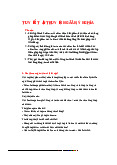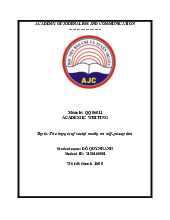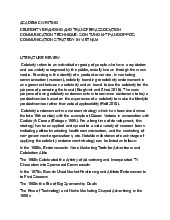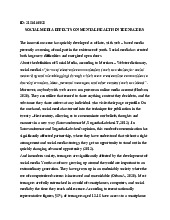






Preview text:
lOMoAR cPSD| 46560390
ACADEMY OF JOURNALISM AND COMMUNICATION
Topic: The psychological effects of social media on adolescents
Student name: Dao Nguyen Phuong Uyen
Student ID: 2156160047 Words count: 1457 lOMoAR cPSD| 46560390
Adolescence is an important period in human lives when physical, cognitive and
psychosocial development starts shifting. In this day and age, most children have early
access to social media. Thus, social media creates a new pattern of social interaction
as the base for their development in adolescence. Unfortunately, social media has been
reported to have bad influences on adolescents’ psychological growth. It is crucial to
understand the link between social media and adolescents’ mental health in order to
intervene as soon as possible. To explore the issue, this paper concentrates on the
negative psychological impacts that social media has on adolescents through three
main parts: introduction, main body and conclusion. Several mental problems due to
social media will be discussed within the body.
In the past decade, social media has proven itself to be playing an indispensable role
in people’s lives. Such impacts on society have drawn an enormous amount of
attention from theorists. It was early stated that social media consists of a variety of
Internet-based and mobile services that enable users to engage in online
conversations, contribute user-generated content, and join virtue communities
(Dewing, 2010). Later on, Carr and Hayes (2015) presented a similar yet more
detailed definition of social media, emphasizing how opportunistically users interact
and self-present with both broad and narrow audiences, either in real-time or
asynchronously. Regarding the ability to assist users in engaging in both interpersonal
and mass communication, social media tools such as Facebook, Instagram, Twitter
are considered the most ideal (Carr and Hayes, 2015; Walther et al., 2010).
Concerning social media use, it is widely believed that this means of communication
is an integral part of adolescents’ lives (Rideout and Fox, 2018). Pew Research Center
(2018) reported that fully 95% of them have access to smartphones, and 45% are
constantly online. Particularly, adolescence is simply defined as the phase of life
between childhood and adulthood, from ages 10 to 19 (World Health Organization,
n.d). During this stage, humans experience rapid physical, cognitive and psychosocial
development. Furthermore, it is estimated that globally, 1 in 7 adolescents experience lOMoAR cPSD| 46560390
mental health problems while anxiety disorder and depression are respectively two of
the most common disorders (World Health Organization, 2021; Stansfeld et al., 2016).
Generally, the term “psychological effect” is perceived as the influence on one’s mind
and feelings. According to Keles et al. (2020), many pieces of research have illustrated
a link between social media and the incidence of depression, anxiety and
psychological distress among adolescents. Specifically, people who suffer from
depression will be negatively affected on their thinking, feeling as well as behaviors
(Torres, 2020). Meanwhile, according to Muskin (2021), anxiety disorders involve
excessive fear or anxiety. These mental conditions tremendously affect the
psychological growth of adolescents.
Following the issue, there has been much quality research on the psychological effect
of social media on adolescents. It is noted that in many cases, social media helps
adolescents access social support easier (Singleton et al., 2016; Best et al., 2014).
However, it is undeniable that the connection between social media and psychological
incidents such as depression and anxiety is relatively strong (Dhir et al., 2018; Kelly
et al., 2018; Best et al., 2014; Keles et al., 2020). Interestingly, most researchers agree
that the impact is multifactorial due to certain mediating factors (Keles et al., 2020;
Coyne et al., 2019; Kelly, 2018). Therefore, compulsive use becomes the primary
cause as it results in different strains that correlate with these incidents (Keles et al.,
2020; Dhir et al., 2018; Kelly et al., 2018). Furthermore, there have been opposing
results about whether the amount of time spent is in direct proportion to the
psychological impact. Indeed, Coyne et al. (2019) stated that their eight-year
longitudinal study revealed no evidence that time spent using social media might
influence an individual’s mental health over time. Instead, it is about how adolescents
use social media (Coyne et al., 2019; Singleton, 2016). Overall, the papers have
contributed to the understanding of society about a controversial issue and paved the
way for future examinations to take an insight into the problem.
Taking into account many pieces of research’s conclusions, it is safe to say that
excessive use of social media leads to depression in adolescents. In accordance with
the social comparison theory (Festinger, 1954), people have a tendency to assess their lOMoAR cPSD| 46560390
opinions and behaviors based on the act of comparing themselves to others. Myers
and Crowther (2009) also argued that this happens more often in adolescents than in
other age groups. Using social media, increased screen-time results in increased
exposure to a variety of content that depicts peer pressure and unrealistic beauty
standards. As a result, the continuous comparisons engender low self-esteem.
Noticeably, the impacts on active and passive users are different. While active users
choose to express themselves, passive users can only consume that content
(Thorisdottir et al., 2019). Furthermore, since users on social media selectively
selfpresent through positive matters and downplay the negative, it is a lot more
dangerous for passive users. The perception of a poor body image constantly stresses
out teenagers and creates depressive symptoms. For instance, Rideout and Fox (2018)
reported that more than half of the adolescents taking part in their survey have
experienced social comparison pressure, with 57% saying they feel like other people
are doing better than they are. Meanwhile, Appel et al. (2016) pointed out that passive
Facebook use predicts social comparison and envy that later lead to depression. In
brief, using social media passively is more likely to result in depression triggered by low self-esteem.
Additionally, anxiety disorder is another psychological incident that adolescents
usually confront due to compulsive social media use. The continual requirement to be
engaged in the online world results in fear of missing out (FoMO). FoMO is
characterized by the desire to be in constant connection with what others are doing
(Przybylski et al., 2013). As adolescents spend most of their time on social media
keeping in touch with friends and updating news (Watson, 2022), it becomes a crucial
part of their daily lives. Thus, they feel the urge to continually engage so as to maintain
a sense of belonging. As a result, an inordinate amount of time spent on social media
not only affects their quality of life but also creates stress whenever they are not able
to access them. In addition, FoMO also brings about excessive anxiety through
insomnia which is a mediating variable. Adequate sleep is considered an important
factor in improving mental health. By contrast, insomnia causes difficulties falling as
well as staying asleep and in the long term, it leads to exhaustion and anxiety
(Freeman et al., 2017). Indeed, social media use can contribute to insomnia in lOMoAR cPSD| 46560390
adolescents in multiple ways. Particularly, FoMO plays the role of sleep disruption,
whilst screen exposure before going to bed can impact the melatonin production that
causes problems falling asleep. For example, the study conducted by Kelly et al.
(2018) suggested that “≥ 5 h using social media was associated with ≈ 50% lower
odds of 1 h more sleep”. In turn, adolescents who lack quality sleep have higher
anxiety scores, “≤ 7 h associated with 19% higher scores than 9 h sleep”. Overall,
compulsive use of social media can result in fear of missing out as well as insomnia
which prompts anxiety in adolescents.
To illustrate the psychological impact of social media on adolescents, taking an insight
into the “Reverse Selfie” film from the Dove Self-Esteem Project is a great choice.
This particular example focuses on how increased screen time during the pandemic
has affected teenage girls’ self-esteem. A new Canadian study conducted by the Dove
Self-Esteem Project in 2020 revealed that most of the girls ages 10-17 years old
surveyed stated that the unrealistic beauty images on social media gradually hurt their
confidence: 67% of girls say they end up feeling judged on the way they look and
66% of girls are worried about their appearances. The repressed feeling of poor self-
assurance might lead to depressive symptoms. Therefore, Dove took action and
helped promote self-esteem among teenage girls by publishing the “Reverse Selfie”
film which highlights the pressure that adolescents have to face due to social
comparison through selfies on social media.
In conclusion, the psychological effect of social media on adolescents creates
depression and anxiety. However, this impact is multifactorial. The act of compulsive
use is a stressor while its results as low self-esteem, fear of missing out and insomnia
are the strains, gradually affecting adolescents’ mental health (Dhir et al., 2018).
Understanding the psychological impacts of social media on adolescents’ well-being
may help come up with measures in the future to limit the negative impacts and
nurture the benefits so that social media can serve humans solely as a useful tool
instead of a double-edged sword. lOMoAR cPSD| 46560390 References
Appel, H. G. A. L. &. C. J., 2016. The interplay between Facebook use, social comparison, envy,
and depression. Current Opinion in Psychology, Volume 9, pp. 44-49.
Best, P. M. R. &. T. B., 2014. Online communication, social media and adolescent wellbeing: A
systematic narrative review. Children and Youth Services Review, Volume 41, pp. 27-36.
Carr, C. T., & Hayes, R. A., 2015. Social media: Defining, developing, and divining. Atlantic
journal of communication, 23(1 ), pp. 46-65.
Coyne, S. M. et al., 2019. Does time spent using social media impact mental health?: An eight
year longitudinal study. Computers in Human Behavior.
Dewing, M., 2010. Social media: An introduction. 1st ed. Ottawa: Library of Parliament.
Dhir, A. Y. Y. K. P. &. C. S., 2018. Online social media fatigue and psychological wellbeing—A
study of compulsive use, fear of missing out, fatigue, anxiety and depression. International
Journal of Information Management, Volume 40, pp. 141-152.
Festinger, L., 1954. A theory of social comparison processes. Human relations, 7(2), pp. 117-140.
Freeman, D. S. B. G. G. M. Y. L. M. N. A. H. P. J. .. &. E. C. A., 2017. The effects of improving
sleep on mental health (OASIS): a randomised controlled trial with mediation analysis. The Lancet
Psychiatry, 4(10), pp. 749-758.
Keles, B., McCrae, N., & Grealish, A., 2020. A systematic review: the influence of social media
on depression, anxiety and psychological distress in adolescents. International Journal of
Adolescence and Youth, 25(1), pp. 79-93.
Kelly, Y. Z. A. B. C. &. S. A., 2018. Social media use and adolescent mental health: Findings from
the UK Millennium Cohort Study. EClinicalMedicine, Volume 6, pp. 59-68. lOMoAR cPSD| 46560390
Muskin, P. R., 2021. American Psychiatric Association. [Online]
Available at: https://www.psychiatry.org/patients-families/anxiety-disorders/what-are- anxietydisorders [Accessed 4 3 2022].
Myers, T. A. &. C. J. H., 2009. Social comparison as a predictor of body dissatisfaction: A
metaanalytic review. Journal of Abnormal Psychology, 118(4), pp. 683-698.
Pew Research Center, 2018. Pew Research Center. [Online]
Available at: Pew Research Center [Accessed 26 3 2022].
Przybylski, A. K., Murayama, K., R.DeHaan, C. & Gladwell, V., 2013. Motivational, emotional,
and behavioral correlates of fear of missing out. Computers in Human Behavior, 29(4), pp. 1841 - 1848.
Singleton, A. A. P. &. S. I. C., 2016. Online social networking and psychological experiences: the
perceptions of young people with mental health difficulties. Computers in Human Behavior, Volume 61, pp. 394-403.
Stansfeld, S. C. C. B. P. E. K. M. J. R. &. H. S., 2016. Common mental disorders. In: NHS Digital. s.l.:s.n.
Thorisdottir, I. E. S. R. A. B. B. A., 2019. Active and Passive Social Media Use and Symptoms of
Anxiety and. Cyberpsychology Behavior and Social Networking, 22(8), pp. 535-542.
Torres, F., 2020. American Psychiatric Association. [Online]
Available at: https://www.psychiatry.org/patients-families/depression/what-is-depression [Accessed 6 3 2022].
Victoria Rideout, M. a. S. F., 2018. Digital Health Practices, Social Media Use, and Mental
WellBeing Among Teens and Young Adults in the U.S., s.l.: y Hopelab and Well Being Trust.
Walther, J. B., Carr, C. T., Choi, S. S. W., DeAndrea, D. C., Kim, J., Tong, S. T., & Van Der Heide,
B., 2010. Interaction of interpersonal, peer, and media influence sources online. In: A networked
self: Identity, community, and culture on social network sites. New York: Routledge., pp. 17-38.
Watson, A., 2022. Statista. [Online]
Available at: https://www.statista.com/statistics/1124159/us-generational-social-media-news/ [Accessed 3 4 2022].
World Health Organization, 2021. World Health Organization. [Online]
Available at: https://www.who.int/news-room/fact-sheets/detail/adolescent-mental-health [Accessed 27 3 2022].
World Health Organization, n.d. World Health Organization. [Online] Available
at: https://www.who.int/health-topics/adolescent-health#tab=tab_1 [Accessed 25 3 2022].



